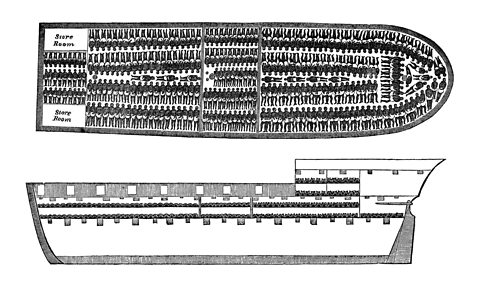The Caribbean and the trade in enslaved people
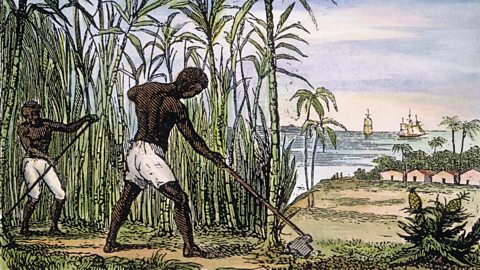 Image source, ALAMY
Image source, ALAMYQuick version
The trade in enslaved Africans left a lasting legacy for the Caribbean islands:
- The indigenousThe original people of a region existing with their own culture, society and political structures before the arrival of foreign colonisers. population of the Caribbean was virtually wiped out by disease and illness.
- Millions of enslaved Africans brought different cultural traditions to the Caribbean.
- The original culture, language, and traditions of the original native American people was largely lost.
There was ecological damage done to the islands:
- Forests were cleared to plant valuable crops such as sugar, coffee, and tobacco.
- Biodiversity was damaged as single crops were planted.
Economic damage was done to Caribbean islands:
- Single crops dominated the islands. In the Caribbean, it was largely sugar.
- There was little economic diversity.
- When prices for the crop dropped, the economy was devastated.
Lasting political damage was done to the Caribbean island:
- Racist laws and attitudes designed to subdue the black majority persisted long after the end of the slave trade.
Learn in more depth
Effects on people and culture of the Caribbean
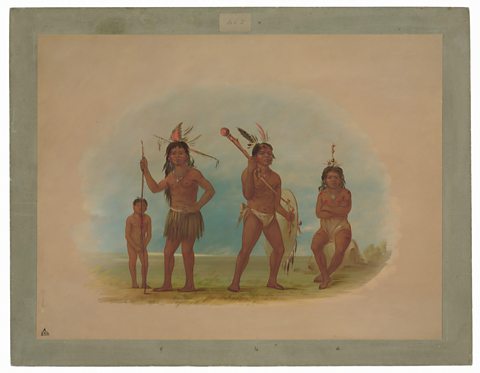 Image source, ALAMY
Image source, ALAMYThe original people living in the Caribbean at the time of European colonisation were indigenousThe original people of a region existing with their own culture, society and political structures before the arrival of foreign colonisers. people such as the Arawak and the Taino.
The Europeans first used these people as labour on the plantations. Disease killed many of the Arawak and Taino people, and soon there were not enough indigenous people to meet the ever growing European demands.
An captive workforce provided the solution, and millions of enslaved Africans were transported across the Atlantic to work on Caribbean plantations. Over a short period of time, black populations became the majority in most Caribbean islands.
This led to lasting changes:
- The population of indigenous people was largely wiped out.
- Black Afro-Caribbean people became the majority population for most Caribbean countries
- Arawak and Taino language and culture was virtually eradicated from the Caribbean.
- African languages, culture, food, and religions were established in the Caribbean.
- European languages, culture, laws and traditions became established as Caribbean islands became European colonies.
Over time a new Caribbean culture began to emerge. European, African and indigenous people, languages, food, and culture began to intermix. This mixing of peoples and cultures produced new culture and new Creole and Caribbean English languages.
 Image source, ALAMY
Image source, ALAMYEnvironmental impacts on the Caribbean
 Image source, ALAMY
Image source, ALAMYThe increasing demand for goods such as sugar, cotton, coffee, and tobacco led to the creation of larger plantations.
To create the plantations, forests were cut down and land was cleared to make way for valuable crops. This destroyed the natural beauty of the islands and damaged its ecology. This in turn:
- Destroyed plant biodiversityThe variety of different plants and animals in an area..
- Destroyed habitatAn environment where a particular species of animal or plant lives. for insects and animals.
The plantations took up just about all arable land. This meant small farms growing a range of food stuff were lost.
 Image source, ALAMY
Image source, ALAMYEconomic impacts on the Caribbean
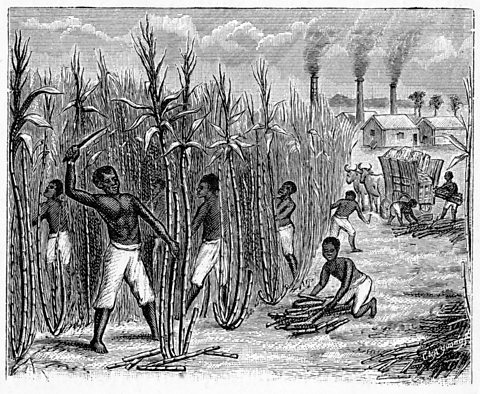 Image source, ALAMY
Image source, ALAMYLarge single-crop plantations stifled the island economy. Growing only one crop – such as sugar cane – meant that if the price of sugar fell, an entire island's economy was seriously affected.
In Barbados, 93% of exports were sugar. When European nations realised that they could get sugar for a cheaper price from countries such as India and Brazil, Barbados was unable to compete and their economy crashed as they had no other products or services to rely on.
With the plantations needing such a large workforce, other industries or farms could not develop as available labour was working in the fields at the plantations.
Even after the end of slavery, the economic opportunities for black Caribbean people remained difficult.
Most black people on Caribbean islands had worked in unskilled farm labour on the plantations. After the end of slavery, this continued. Pay was low and living conditions were usually poor.
To compound the problem, the vast profits made by the plantations also did little for the Caribbean islands.
Most of the money ended up back in Britain rather than being re-invested in the Caribbean as plantation owners bought large houses and lived lavish lifestyles back in British cities.
Little was invested in new industries and so, long after the end of the trade in enslaved people, the economies of Caribbean islands remained centred on large plantations growing single crops harvested by an unskilled and poorly-paid black workforce.
 Image source, ALAMY
Image source, ALAMYThe political impacts on the Caribbean
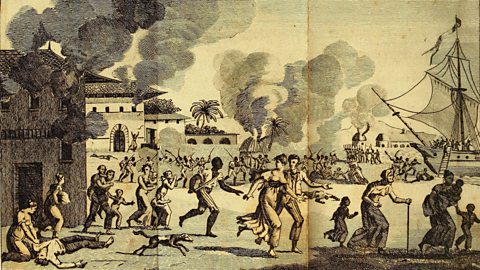 Image source, ALAMY
Image source, ALAMYThe enslaved black populations made up between 70-90% of the overall population in the Caribbean. As such, the Europeans masters lived in fear of rebellions.
New Slave Codes were introduced to the Caribbean by the European powers to control the black population. The Slave Codes:
- Removed basic civil rights from black people.
- Legally defined black people as property of the plantation owners.
- Gave owners the right to physically punish enslaved people.
- Limited the enslaved people's right to travel.
- Limited enslaved people's right to marry.
- Limited economic opportunities for black and enslaved people.
These laws were enforced by armed white militias and, in some cases, by British soldiers posted to the islands.
The harshness of the laws and the terrible conditions enslaved people endured led to rebellions an risings that led to battles. Many people died in these risings and serious damage was done to Caribbean towns and settlements.
These laws also entrenched racist European views about black people that continued to exist in the Caribbean long after the end of the trade in enslaved people.
Long after the trade in enslaved people ended, many Caribbean nations remained under European control.
- Martinique, Guadeloupe, Saint Martin, and St. Barth are still French Caribbean territories.
- The British Virgin Islands, the Cayman Islands, Montserrat, the Turks and Caicos Islands, and Anguilla are British Caribbean territories.
 Image source, ALAMY
Image source, ALAMYTest what you have learned
Quiz
Recap what you have learned
The trade in enslaved Africans did lasting damage to the Caribbean islands:
Change to the people of the Caribbean:
- Arawak and Taino native Americans and their culture were virtually wiped out.
- Europeans colonised the Caribbean and imposed their culture on the islands.
- Large enforced migration of enslaved Africans further changed the culture of the Caribbean.
Environmental damage:
- Single crop plantations destroyed Caribbean habitats and environment.
Economic damage:
- Dominance of single crops led to economic disaster if the price or demand for the crop fell.
- Black populations were kepyt working low-skilled, low paid farm jobs even after the end of the trade in enslaved people.
Political damage:
- Slave Codes designed to subdue larger enslaved African populations persisted after the end of slavery.
- Many Caribbean islands remained under European control after the end of the trade in enslaved people.
More on Trade in enslaved African people
Find out more by working through a topic
- count10 of 10

- count1 of 10
